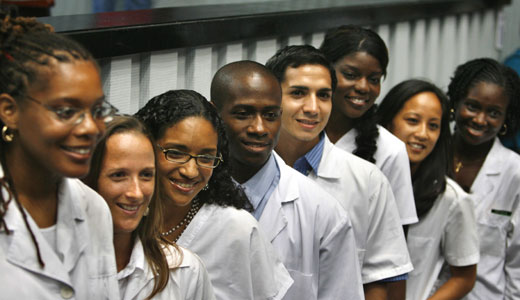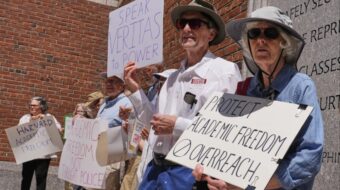
University education in Cuba is heading for big changes. The force behind them is the wave of major economic reforms moving through Cuban society, reforms necessary, Cuban leaders say, to preserve socialism.
Many regard Cuba’s success in making education accessible and socially useful to have been a prime achievement of the Cuban Revolution. Indeed, at any given time, roughly one fifth of all Cubans are enrolled in one or another kind of school. Universities increased from three in 1959 to the present 67. And eleven percent of Latin American scientists obtained their PhD’s in Cuba.
Beginning in 2000, so-called municipal university centers came into being that, offering televised courses, extended university education to small towns and rural areas. Then something happened: 122,193 fewer students entered Cuban universities in the academic year 2011-2012 than in the year before. From 744,000 entering students in 2007-2008, the number fell over four years to 351,000. There were far fewer CUM’s, and their enrollment was down 50 percent. That a disproportionate number of CUM students were studying social sciences may have been significant.
Tightened requirements for university study contributed to declining enrollment. But other factors were at work. As higher education officials saw it, university curricula were becoming less and less relevant in a nation undergoing economic readjustment. Students by and large had been studying medicine, biotechnology, information sciences, tourism, pedagogy, social sciences, and humanities. Not all these curricula fit current needs, say those in charge, especially the latter two.
Education officials had already been dealing with the problem of declining numbers of teachers. Low pay was forcing many of them into part-time work or causing them to leave the profession. Concerned that the resulting over-filled classrooms were detrimental to the quality of pre-university education, authorities have been working to find replacement teachers, including efforts to recruit retired teachers.
Educational funding remains stable: 12.9 percent of the GDP in 2010, up from 11.9 percent in 2007. That’s tops in the world except for East Timor, according to World Bank figures. Paying for university education – students pay nothing – represents 4.4 percent of Cuba’s GDP. Reallocations have been necessary, however, among them a cutback in scholarships for foreign students studying at Cuba’s flagship Latin American School of Medicine.
Changing university education was in the air in July as higher education Minister Rodolfo Alarcón reported to the Cuban Parliament. Amidst “profound transformations,” his ministry wants universities to promote scientific and technical innovations, carry out research benefitting society and the economy, provide special support for basic science students, and prepare graduates to meet the needs of individual regions in the country. University enrollments must increase, he said.
The Higher Education Ministry website mentions goals of “achieving greater pertinence, efficiency, rationality, and integration in all types of courses.” Cuba wants to train “professionals who are highly competent and committed to society and revolutionary principles.”
Emphasis has turned to vocational training, and away from study areas without immediate application. More and more students will be preparing to become technicians and agricultural specialists. The overall purpose, reports Inter Press Service, source of much of this information, is “the necessity to revitalize the productive sector of the country…particularly on the land.” Cuba’s need to import great amounts of expensive food products imposes an overwhelming burden. Building up domestic agricultural capabilities is a crucial part of Cuba’s current economic reform program.
In some ways re-direction of higher education is a return to Cuba’s revolutionary roots. Speaking to students and faculty in 1959, Che Guevara advised universities to prepare students for practical work in the “heart of the people.”
According to Victor Pérez Galdós, reporting on current university reforms for Rebel Radio, Che reminded listeners that universities “belong to the people of Cuba.” In 1962, Che explained that necessities of the time meant, “for the sake of future industrial development a great lumber of engineers and thousands of technicians were necessary.”
He emphasized the importance of technicians and students relating closely with manual workers.
Photo: Cuban medical schools are thought of as being among the best in the world. Javier Gerleano/AP










